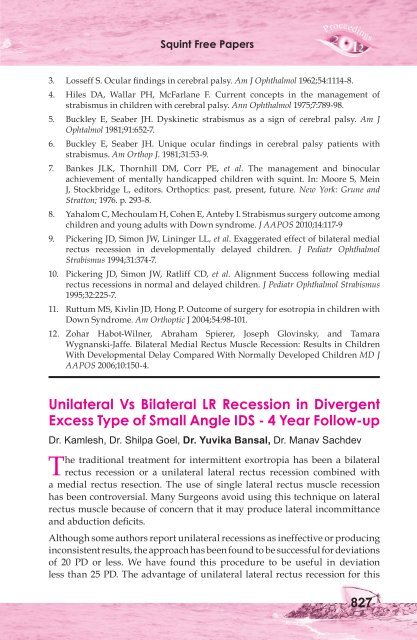Squint Free Papers - aioseducation
Squint Free Papers - aioseducation
Squint Free Papers - aioseducation
Create successful ePaper yourself
Turn your PDF publications into a flip-book with our unique Google optimized e-Paper software.
<strong>Squint</strong> <strong>Free</strong> <strong>Papers</strong><br />
3. Losseff S. Ocular findings in cerebral palsy. Am J Ophthalmol 1962;54:1114-8.<br />
4. Hiles DA, Wallar PH, McFarlane F. Current concepts in the management of<br />
strabismus in children with cerebral palsy. Ann Ophthalmol 1975;7:789-98.<br />
5. Buckley E, Seaber JH. Dyskinetic strabismus as a sign of cerebral palsy. Am J<br />
Ophtalmol 1981;91:652-7.<br />
6. Buckley E, Seaber JH. Unique ocular findings in cerebral palsy patients with<br />
strabismus. Am Orthop J. 1981;31:53-9.<br />
7. Bankes JLK, Thornhill DM, Corr PE, et al. The management and binocular<br />
achievement of mentally handicapped children with squint. In: Moore S, Mein<br />
J, Stockbridge L, editors. Orthoptics: past, present, future. New York: Grune and<br />
Stratton; 1976. p. 293-8.<br />
8. Yahalom C, Mechoulam H, Cohen E, Anteby I. Strabismus surgery outcome among<br />
children and young adults with Down syndrome. J AAPOS 2010;14:117-9<br />
9. Pickering JD, Simon JW, Lininger LL, et al. Exaggerated effect of bilateral medial<br />
rectus recession in developmentally delayed children. J Pediatr Ophthalmol<br />
Strabismus 1994;31:374-7.<br />
10. Pickering JD, Simon JW, Ratliff CD, et al. Alignment Success following medial<br />
rectus recessions in normal and delayed children. J Pediatr Ophthalmol Strabismus<br />
1995;32:225-7.<br />
11. Ruttum MS, Kivlin JD, Hong P. Outcome of surgery for esotropia in children with<br />
Down Syndrome. Am Orthoptic J 2004;54:98-101.<br />
12. Zohar Habot-Wilner, Abraham Spierer, Joseph Glovinsky, and Tamara<br />
Wygnanski-Jaffe. Bilateral Medial Rectus Muscle Recession: Results in Children<br />
With Developmental Delay Compared With Normally Developed Children MD J<br />
AAPOS 2006;10:150-4.<br />
Unilateral Vs Bilateral LR Recession in Divergent<br />
Excess Type of Small Angle IDS - 4 Year Follow-up<br />
Dr. Kamlesh, Dr. Shilpa Goel, Dr. Yuvika Bansal, Dr. Manav Sachdev<br />
The traditional treatment for intermittent exortropia has been a bilateral<br />
rectus recession or a unilateral lateral rectus recession combined with<br />
a medial rectus resection. The use of single lateral rectus muscle recession<br />
has been controversial. Many Surgeons avoid using this technique on lateral<br />
rectus muscle because of concern that it may produce lateral incommittance<br />
and abduction deficits.<br />
Although some authors report unilateral recessions as ineffective or producing<br />
inconsistent results, the approach has been found to be successful for deviations<br />
of 20 PD or less. We have found this procedure to be useful in deviation<br />
less than 25 PD. The advantage of unilateral lateral rectus recession for this<br />
827

















